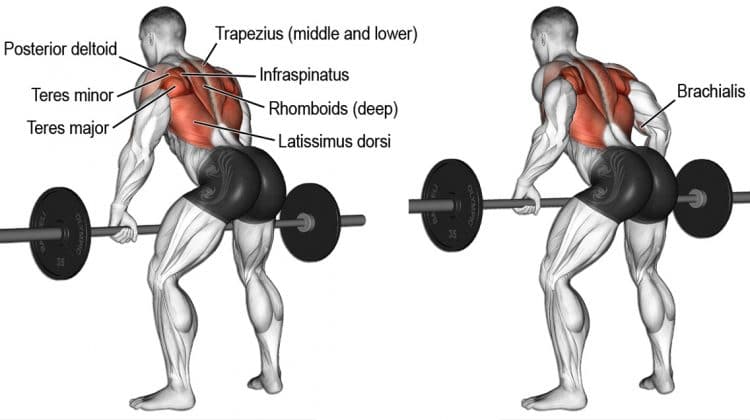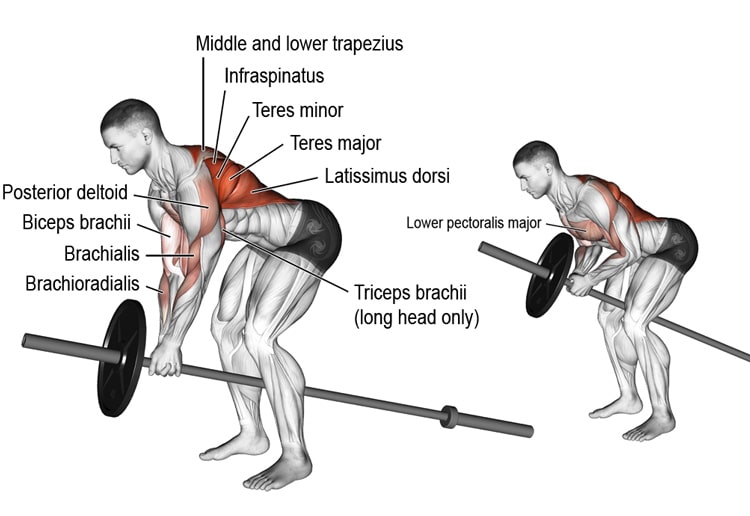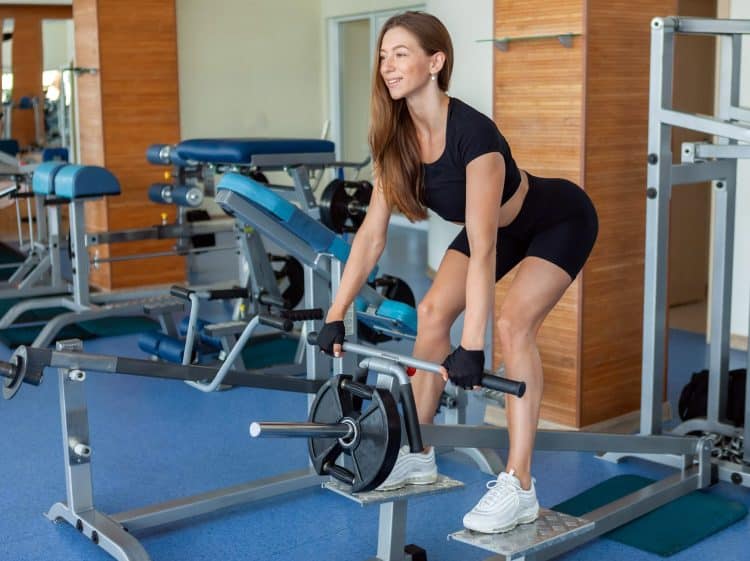The Barbell and T-bar rows are functional back-strengthening movements that can help build a big and monstrous back and strengthen the entire posterior chain.
However, if you had to choose between the two for your training program, you should know the differences to make the right call since both include a similar pulling pattern.
The T-bar row is an isolation exercise, whereas the barbell row is a compound exercise. T-bar rows target the latissimus dorsi, trapezius, posterior deltoids, and rhomboids, while barbell rows target the same back muscles, but passively target the hamstrings and erector spinae.
Let’s understand the basics of both exercises before we jump on their differences.
Basics of Barbell Row
The barbell row is one of the best back exercises for building strength and size. It’s a fantastic compound exercise to train almost every posterior chain muscle.

Primary muscles involved in barbell row include:
- Erector spinae
- Latissimus dorsi
- Trapezius
- Posterior deltoids
- Infraspinatus
- Rhomboids
- Teres major and minor
Secondary muscle groups that stabilize and support the lift include:
- Core
- Hamstrings
- Glutes
- Quadriceps
- Calves
- Biceps
- Forearms and grip
Basics of T-Bar Row
The T-bar row is a variation of the conventional barbell bent-over row. In the T-bar row, one end of the barbell is anchored in a corner or landmine attachment. A V-bar handle is attached to the other side, just below the bar’s neck.

Primary muscles involved in the T-bar row include:
- Latissimus dorsi
- Trapezius
- Posterior deltoid
- Rhomboids
- Teres major and minor
Secondary muscles involved in the T-bar row include:
- Biceps & Forearms
- Spinae erector
- Hamstrings
- Glutes
- Core muscles
Now that we know the basics of conventional barbell row and T-bar row, let’s discuss their differences.
Barbell Row vs. T-Bar Row
There are some fundamental differences between both exercises; let’s discuss them in detail.
1. Lifting Experience
How long have you been working out at the gym? This is the first question that you need to ask yourself before you choose between barbell and T-bar row.
Barbell row
A barbell row is a classic back exercise that looks basic but requires a lot of practice to execute properly. The barbell row can increase your odds of injury if you don’t follow the correct form.
Furthermore, the exercise demands core strength and muscle coordination, especially while using heavier loads. Maintaining a strong core and a stable lower body is key to performing the barbell row with the correct form. Many beginners find it hard to hold the bent-over position for a barbell row.

T-Bar row
Elite bodybuilders like Ronnie Coleman and Arnold Schwarzenegger employed the T-bar row to take their back gains to the next level. Additionally, while you pull the barbell vertically towards your abdomen in the conventional barbell row, the T-bar has you follow an arch, which results in a greater posterior muscle chain engagement.
2. Muscle Isolation
Muscle isolation is an important aspect to consider when focusing on hypertrophy. Every individual has weak and dominant muscle groups, and you should be able to isolate the target muscles to fix strength and size imbalances.
Barbell row
After the deadlift, the barbell row is arguably the most popular compound back exercise for building strength and size. However, many lifters find it difficult to establish a mind-muscle connection while performing the barbell row. Additionally, people with lower body pain or injuries might find it hard to perform the compound lift.

T-Bar row
Many lifters prefer the T-bar row over the bent-over barbell row as it helps recruit more muscle fibers than the conventional barbell row due to its bigger range of motion.
Plus, some variations of the T-bar row put less stress on the glutes, hamstrings, and lower back. Also, they offer better control over the range of motion than the conventional barbell row.
3. Versatility
Versatility here refers to the ability to hit muscles from different angles with a slight alteration in technique.
Barbell row
An experienced lifter can use a barbell row to train every part of their back. Here are some bent-over barbell row variations:
- Overhand grip row: Primarily focuses on posterior deltoids, mid traps, and rhomboids while improving core stability and spinal alignment.
- Underhand grip Barbell row: Although it targets all the same muscles as the overhand variation, the focus shifts to the lats and biceps. The underhand grip allows you to train with a heavier weight.
- Rack row: Rack rows are used by more advanced lifters to train for strength. They help develop monstrous traps and grip strength.
- Pendlay row: This rowing variation improves explosive strength and emphasizes upper back development.
- Yates row: The namesake exercise of the six-time Mr. Olympia champ Dorian Yates, the exercise helps build a thicker back and usually involves lifting heavy.
Apart from different rowing variations, you can always experiment with a wide and narrow grip to check what works best for you.
T-Bar row
You could use a range of handles and T-bar machines to add variety to your back training. Additionally, you might have to cycle through different T-bar variations to figure out which works best for you.
Some popular variations include the conventional T-bar row using an anchored barbell and a double D-handle attachment, the old-school T-bar machine with an elevated platform, and a chest-supported T-bar machine.
4. Injury Prevention
Injury prevention is an important factor that should be kept in mind. Who should be paying more emphasis to injury prevention? Here is the list:
- Bodybuilders in their cutting phase
- Beginners
- People starting training after a long break
- Lifters with a history of sciatica, back or glute injuries
- Anyone older than 45 years
Barbell row
Heavy barbell rows are not for the faint-hearted as there is always a chance of getting injured. Some pro bodybuilders avoid heavy barbell rows in their cutting phase because they are in an extended caloric deficit, and it increases the chances of injury close to the competition.
Additionally, Babell rows require high hip and hamstring mobility.
T-Bar row
Folks who struggle with hip mobility or experience lower back pain should favor the chest-supported T-bar row over the conventional barbell rows.
While doing conventional barbell rows, a lifter is required to keep their torso parallel to the floor, which puts a lot of stress on the lower back, glutes, and hamstrings.
[sc name=”style-blue-box” ]
What makes T-bar a safer option?
The answer lies in the mechanism of both exercises. Although the barbell and T-bar row are excellent back-building exercises, they differ in their load transfer mechanism.
While doing T-bar rows, one end of the barbell is anchored to the ground. The T-bar row is safer because lifters do not need to maintain an aggressive hip hinge during the exercise.
The angle of the torso to the ground is about 30 degrees, relieving additional pressure from the glutes and lower back.
[/sc]

5. Muscle engagement
It refers to the muscle groups working together in an exercise. Both exercises activate the whole posterior chain, including the lats, erector spinae, trapezius, rear delts, core, and biceps.
However, the degree to which the muscles are engaged is different, as the T-bar row can provide deeper lat and upper back stretch at the bottom of the movement due to its neutral grip position while using a double D-handle attachment.
6. Required equipment
How much do you need to invest for a barbell or T-bar row at home? This is a legitimate question for someone looking to set up a garage gym.
Requirements are pretty much the same; you will need a barbell and weight plates for both exercises. However, you’ll need to invest in a V-bar handle and a landmine attachment (optional) for the T-bar row.
7. Range of motion
Machines are usually great for isolation work.
Lifters usually compromise on ROM while training with free weights due to the fear of failing at either end of the range of motion. For example, many lifters perform shallow squats because they are afraid to fail at the bottom of the movement. Many lifters do half-range bench presses for the same reason.
On the other hand, T-bar rows allow a greater range of motion because it reduces stress on stabilizer muscles.
However, that doesn’t mean you should stop doing barbell rows. Instead, emphasize implementing proper form and technique. If you are struggling with your range of motion while doing the barbell row, you should go light and perform a higher number of reps.
Wrapping Up
Choosing between both exercises can be challenging. However, you shouldn’t choose one over the other, especially if you are not dealing with injuries. Both lifts should be a part of your exercise arsenal.
The T-bar row will help you create a strong foundation, but there is no alternative to free-weight barbell rows. The barbell row will not only help develop a monstrous back, but it will also improve your deadlift, squat, and bench press.


